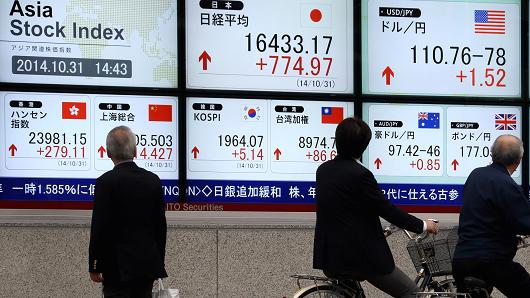On December 2, Japan’s Nikkei 225 index closed at a fresh seven-year high as investor sentiment was buoyed by talk of the Bank of Japan (BoJ) buying stocks.
The benchmark Nikkei 225 closed up 0.4% at 17,663.22 points.
Earlier, the index had fallen after Moody’s Investment Service cut Japan’s credit rating by one notch to A1 from Aa3.
Moody’s move underlined concerns over Japan’s economy after an increase in the national sales tax was delayed.
However, analysts said the weaker yen, together with the possible move by the BoJ, was continuing to support investor sentiment.
China shares rallied on speculation that the country’s central bank was preparing to reduce bank reserve requirement ratios sooner than expected on recent economic data showing a much weaker economy.
In Hong Kong, the Hang Seng index closed up 1.2% at 23,654.30, while the Shanghai Composite rose 3.1%, to 2,763.54 – its best daily rise since September 2013.
Australia’s benchmark S&P/ASX 200 index closed up 1.4% at 5,281.30 points.
The upward movement in Australia followed the biggest fall since October 10 on December 1 amid a sell-off in mining and energy related shares.
Ahead of economic growth figures due out on December 3, the Australian Bureau of Statistics (ABS) reported on December 2 that net exports had added 0.8 percentage points to gross domestic product (GDP) in Q3.
The quarterly rise in exports for the three months to September is a sign that GDP data due out on December 3 will be positive.
As expected, Australia’s central bank maintained its record low official interest rates at its monthly meeting on December 2.
The bank’s interest rate has been at 2.5% since August last year.
In South Korea, the benchmark Kospi was little-changed, closing up just 0.03% at 1,965.83 points.
